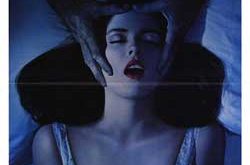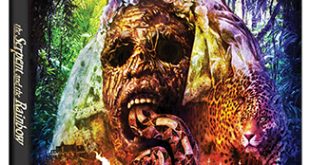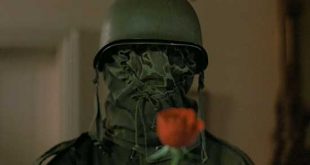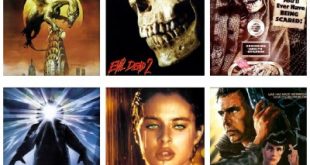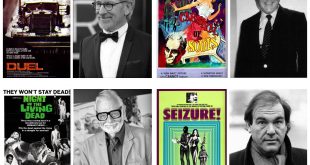![hills_have_eyes[1]](https://horrornews.net/wp-content/uploads/2011/09/hills_have_eyes1-320x500.jpg) More and more I’m forgetting the past…
More and more I’m forgetting the past…
Webb Pierce’s lyrics open the remake to Wes Craven’s The Hills Have Eyes, and upon watching the remakes that have littered the wasteland of the horror landscape over the past decade, few songs seem more befitting to a remake of one of Craven’s most feminist works.
It’s not that I entirely dislike Alexandre Aja’s 2006 remake of The Hills Have Eyes, it’s simply that I don’t care for it one way or the other. It’s slick, it’s pretty, and it spends its first ten minutes establishing the gruesomeness of nuclear warfare, nuclear testing, and human dismemberment.
Though I could simply hang my hat on the nostalgic desire of low-budget filmmaking and call it a day – Craven’s original was made for $350,000.00 and Aja’s remake was made for a mind-boggling $15 million – simply dismissing a film because it cost more to produce is hardly a valid reason to like the original over the remake.
My ultimate problem with Aja’s remake is that the original feminist subtext of Craven’s storyline has been completely stripped away, leading me to wonder, why am I watching this? Is it to warn us of the dangers of nuclear testing? Is it a critique of the government? Is it a critique of mutants? (And why is Doug so f*cking annoying? Is it because he’s a liberal? Is this just a hatred of the suburban family unit? And can someone please tell baby Catherine to stop f*cking crying??)
Craven’s background is hardly a secret to any horror fan.
He earned his graduate degree in Philosophy and Writing at John Hopkins. He then taught as a professor until quitting at the age of thirty to make the Sean S. Cunningham produced The Last House on the Left. The film assisted in catapulting the careers of both Cunningham and Craven, who wound up spearheading the most successful franchises in horror film history. Cunningham, in particular, has been quoted by many film sites as stating the following:
“You can’t do anything new with special effects; you can’t get any mileage out of killing more people or being more graphic, because it’s all be done – you should excuse the expression – to death. The p*rnography of violence is similar to the p*rnography of sex, in that when it’s presented without substance it becomes a turn-off and it self-destructs.”1
While I’m still trying to ascertain why Aja went such a graphically violent route with the behavior of mutants that are both physically and mentally deformed – why exactly does Lizard ooze bird blood all over his upper lip? Is he just that poorly coordinated that he can’t get it into his mouth? – Craven’s 1977 classic clearly spends its time concentrated on visually portraying substance that its remake seems to fall short of accomplishing.
Craven’s original juxtaposes two families against one another. The first is the suburban family – the father of which is a retired police officer – who become stranded in the desert after Dad loses control of his temper and accidentally crashes the family’s station wagon with camper attached after he ignores pleas by his wife and daughter to turn the station wagon around. The second family is the family of cannibals who eat dogs, snakes, and humans, and use the hides of these creatures to cloth themselves.
When they come across the suburban family in the desert, they coordinate a plan to steal the family’s baby not as a means to adopt it into their culture, but to eat it because, obviously, baby fat is the most delicious. In short, they kill whoever gets in their way and recognize only one authority figure – the father.
Wes Craven’s ideological assertion is clear: when the economic aspect of society is stripped away from the social structure (that is, we put our subjects in the vacuum of a desert), what is left standing is a patriarchal structure where women are forced into subordinate positions and alpha males embodying masculine ideals remain in power. However, Craven’s film takes his message one step further.
Though Craven portrays the family unit and dominant social structure as oppressive, he does offer the potentiality for social upheaval led by women. As a means by which to articulate his message, Craven follows the tradition of Alfred Hitchcock by using Sigmund Freud in order to inform his audience regarding the failure of a patriarchal society. Rather than simply show his audience phallic symbols at work and hope the audience understands his message, Craven bluntly smacks his audience across the face with dialogue as shown by the infamous line delivered by Bobby to his mother, “you know what Freud would say about your obsession with rattlesnakes, don’t you mother?” His mother waves off this comment as nonsense.
However, the finale culminates in the destruction of murderers by way of female ingenuity combined with deadly phallic symbols. It is Brenda who first concocts the trap to catch Jupiter. Though her original plan fails – the station wagon aka the remaining signifier of civilization (along with the camper) runs out of gas – she follows up with a hatchet to Jupiter’s back, thus ending the patriarchal rule of one uncivilized freak. However, in the original, it’s not just the suburban woman who has the opportunity to rise above. Ruby, the oppressed female cannibal is also afforded the opportunity to reclaim her independence and assert herself. While Doug struggles for his survival in his rescue attempt of the baby, Ruby saves the child by capturing – wait for it, wait for it – a rattlesnake and sticking it onto the neck of her older brother. That’s right, the very rattlesnakes that mother feared/obsessed over earlier, have been used to save humanity – all thanks to a woman.
Perhaps there’s value in over-the-top violence and mutants who pretend to play house. I just haven’t figured it out yet. I’m not certain why, in 2006, a film centered around the destruction of humans thanks to government testing seems pertinent. It appears largely to be a vague reference to the abuses and the secrecy of the Bush administration – and such an analysis would be a fair one (though the link seems too far detached).
However, the lack of explicitness in the message and the concentrated focus on blood and gore raises the question of how the gore and blood coincide harmoniously with the message (if we are to believe that the message is, in fact, one regarding government abuses of power and secrecy…why are the mutants so evil? Shouldn’t we have more sympathy for them if we’re to be angry at the government for this cover-up? Instead they’re vile, grotesque, angry, and horny…and rather than having the women take charge, Doug goes into berserker mode after facing death in its distorted mug…at which point I might get caught up in the moment and start yelling “Go Doug!!” if I didn’t find him so goddamn whiny in the opening of the film).
Though I’m not a huge fan of the remake, I will give Aja credit for his cinematic beauty and attempt to make a socially-relevant film compared to some of the remakes put out by larger production companies. However, even Aja’s message seems incredibly muted versus the explicitness of the original, and in effect, for this horror fan, ultimately disappoints.
1 This quote has been attributed by IMDB, Movie Mire, and Weblo:
http://www.imdb.com/name/nm0192446/bio
http://www.weblo.com
http://www.moviemire.com
 Horror News | HNN Official Site | Horror Movies,Trailers, Reviews
Horror News | HNN Official Site | Horror Movies,Trailers, Reviews
![last_house_on_the_left_ss_krug_and_posse[1]](https://horrornews.net/wp-content/uploads/2011/09/last_house_on_the_left_ss_krug_and_posse1.jpg)
![HillsHaveEyes[1]](https://horrornews.net/wp-content/uploads/2011/09/HillsHaveEyes1.jpg)
![hills_have_eyes_2_splash[1]](https://horrornews.net/wp-content/uploads/2011/09/hills_have_eyes_2_splash1.jpg)
![last_house_on_the_left_xl_05[1]](https://horrornews.net/wp-content/uploads/2011/09/last_house_on_the_left_xl_051.jpg)
![hillshaveeyes1977[1]](https://horrornews.net/wp-content/uploads/2011/09/hillshaveeyes19771.jpg)
